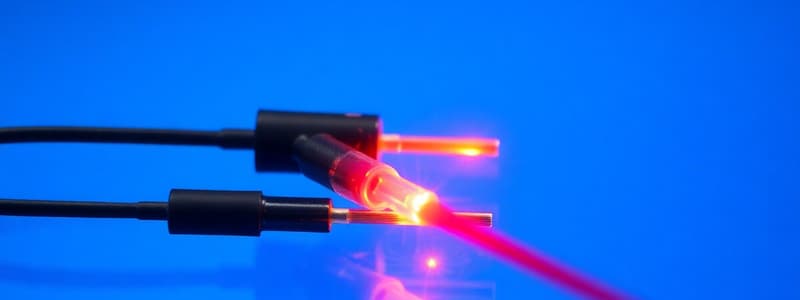Podcast
Questions and Answers
The electrochemical series lists elements in order of their standard ______ potentials.
The electrochemical series lists elements in order of their standard ______ potentials.
electrode
Electrolysis is a chemical reaction that occurs when electricity passes through an ______.
Electrolysis is a chemical reaction that occurs when electricity passes through an ______.
electrolyte
Lead bromide must be molten so that the ______ are free to move.
Lead bromide must be molten so that the ______ are free to move.
ions
A suitable material for the electrodes in electrolysis is ______.
A suitable material for the electrodes in electrolysis is ______.
Sodium can be extracted from sodium ______ by electrolysis.
Sodium can be extracted from sodium ______ by electrolysis.
Electrolysis is the use of electricity to bring about a chemical reaction in an ________.
Electrolysis is the use of electricity to bring about a chemical reaction in an ________.
An ________ is a compound which can conduct an electric current when dissolved in water.
An ________ is a compound which can conduct an electric current when dissolved in water.
In the electrolysis of copper sulfate, the impure copper is used as the positive ________.
In the electrolysis of copper sulfate, the impure copper is used as the positive ________.
Inert electrodes do not react with the ________ they are inserted into.
Inert electrodes do not react with the ________ they are inserted into.
The process of electroplating involves using electrolysis to coat an object with a layer of ________.
The process of electroplating involves using electrolysis to coat an object with a layer of ________.
When electroplating, the object to be plated must be connected to the negative terminal of the ________.
When electroplating, the object to be plated must be connected to the negative terminal of the ________.
In the electroplating reaction, Ag^+ + e^- goes to Ag at the negative ________.
In the electroplating reaction, Ag^+ + e^- goes to Ag at the negative ________.
The impurities from electrolysis of copper settle to the ________ of the cell.
The impurities from electrolysis of copper settle to the ________ of the cell.
Flashcards
Electrolysis
Electrolysis
Using electricity to cause a chemical reaction in a solution (electrolyte).
Electrolyte
Electrolyte
A substance that conducts electricity when molten or dissolved in water.
Electrode (inert)
Electrode (inert)
An electrode that doesn't react with the electrolyte.
Electroplating
Electroplating
Signup and view all the flashcards
Copper Purification
Copper Purification
Signup and view all the flashcards
Electrode (active)
Electrode (active)
Signup and view all the flashcards
Electroplating purpose
Electroplating purpose
Signup and view all the flashcards
Electroplating metal example
Electroplating metal example
Signup and view all the flashcards
Electrochemical Series
Electrochemical Series
Signup and view all the flashcards
Molten Electrolyte
Molten Electrolyte
Signup and view all the flashcards
Inert Electrode
Inert Electrode
Signup and view all the flashcards
Electrode Half-Reactions
Electrode Half-Reactions
Signup and view all the flashcards
Study Notes
Electrochemistry
- Electrochemistry is divided into two areas: using electricity to cause chemical reactions, or using chemical reactions to produce electricity.
- Electrolysis: Using electricity to cause a chemical reaction in an electrolyte. An electrolyte is a compound which, when molten or dissolved in water, conducts an electric current.
- Electrodes: Used to make contact with the electrolyte. Often made of carbon or platinum (unreactive) to avoid reacting with the electrolyte. Some electrodes don't react—inert electrodes; others react with the electrolyte—active electrodes.
- Electroplating: Putting a thin layer of one metal onto another metal using electrolysis.
- Copper purification: Uses electrolysis of copper sulfate solution using copper electrodes. Impure copper is the positive electrode, pure copper is the negative electrode; pure copper plates onto the negative electrode, and impurities fall to the bottom.
- Electrochemical Series: A list of elements ordered by their standard electrode potentials. Elements higher on the list are more reactive, losing electrons more easily.
Electrochemical Series
- The electrochemical series lists elements according to their standard electrode potentials.
- Elements at the top of the series (highly electropositive) readily lose electrons; those at the bottom (least electropositive) do not.
- The series is important for predicting reactivity and spontaneous redox reactions.
Exam Questions (Electrolysis of Molten Lead Bromide)
- Electrolysis: A chemical reaction caused by an electric current passing through an electrolyte.
- Molten lead bromide: Lead bromide must be molten so ions are free to move.
- Suitable electrode material: Platinum is a suitable inert electrode material for the electrolysis of molten lead bromide.
- Half-reactions: The following balanced half-equations apply to the reactions occurring during the electrolysis.
- Pb²⁺ + 2e⁻ → Pb
- 2Br⁻ → Br₂ + 2e⁻
- Metal extracted by electrolysis (other than lead): Sodium
- Compound electrolysed to produce sodium: Sodium chloride (NaCl)
Studying That Suits You
Use AI to generate personalized quizzes and flashcards to suit your learning preferences.




